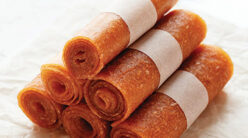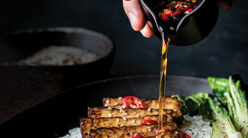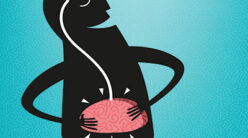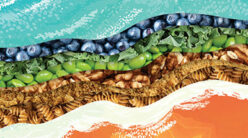Before you wrinkle up your nose and let loose a big “Ick!” consider this fact: Just because you don’t find such items on the menu of your favorite restaurant doesn’t mean they’re not in the food.
Down to the Sea
Take ice cream, pudding, cottage cheese, salad dressing, or chocolate milk. Check the label, and you’ll find the word “carrageen” nestled in with the other ingredients. Fine folk who live and work along the coasts of New England and Canada pull tons of the stuff out of the ocean each year. It’s red, leafy, and totally seaweed.
After being raked into boats, carrageen is taken to processing plants where it’s turned into a tasteless, off-white powder that quickly dissolves in water and becomes jellylike whenever it comes in contact with the proteins found in milk.
Carrageen acts as an emulsifier that keeps food particles evenly distributed in a liquid. Without this gift from the ocean the cocoa particles in chocolate milk would sink to the bottom, and pudding wouldn’t whip up so creamy. It also prevents large ice crystals from forming in ice cream and helps hold together cakes and pastries.
But don’t worry. As an added bonus, you’re getting a sea plant that’s rich in kelp (a source of iodine); B-complex vitamins; vitamins D, E, and K; calcium; and magnesium.
There’s Bark in My Bunt Cake
Vanilla-America’s favorite flavor-started out being made from fibrous parts of woody plants, such as spruce tree bark. Today, vanilla used in the United States also comes from oil.
Artificial vanilla is listed as “vanillin” on the ingredient list. It’s the substance that gives vanilla its flavor and occurs naturally in vanilla beans. But vanillin, which began to be widely used in the 1920s, also is a byproduct of papermaking.
Natural vanilla comes from seedpods that grow on tropical vanilla orchid vines. These vines were first used to flavor foods by the Indians living in Mexico. The unripe pods are harvested and fermented to develop the unique vanilla taste.
The only difference between real vanilla and its artificial twin, vanillin, is that the latter lacks some of the trace elements found in naturally growing seedpods. It’s difficult to tell the difference, but product labels are required to reveal which one is being used.
Colorful Bugs
Ever wonder where some candies, juices, soft drinks, jellies, and dairy products get their nice red color? Well, there’s a tiny, reddish-brown insect living on prickly pear cacti in Mexico and South America that provides such products their ruddy hue.
These little critters are brushed off the cacti into containers and treated with hot water. Then they’re dried and ground into powder. Red powder.
No, you won’t find the word “bugs” on the ingredient label. But you will see “cochineal” or “carmine” listed there.
Cochineal extract is very expensive and it takes about 70,000 of the one-eighth-inch-long insects to create a pound of powder. Over the course of a year, you probably consume only one or two drops of this colorful concoction in the foods you eat.
What Are Food Additives?
Broadly speaking, food additives represent any substance that doesn’t occur naturally in foods. They may be direct additives that enhance flavor, improve texture, or prevent spoilage.
Then there are the “indirect additives” such as environmental pollutants or substances that enter the foods during growing, processing, or packaging.
Some additives such as dyes, artificial flavors, unnecessary applied vitamins, pesticide residues, and other contaminants, we could very well do without. In large amounts, these undesirables could be hazardous to our health. But, on balance, most don’t affect us.
For sometime now we’ve been led to believe that natural is better. More and more products in the supermarket and health food stores grab our attention with labels that scream, “No Additives. No Chemicals. No Artificial Preservatives.” Are these always the best ones to buy?
“We have to demystify that which is not understood,” says Manfred Kroger, Ph.D., professor emeritus of food science at Pennsylvania State University. “The scare over chemical additives was born out of ignorance and is over-blown.” He adds that the exaggerations come from antitechnologists, chemophobics, and others who really don’t understand the rationale for their use and become afraid of the unpronounceable names seen on food packages.
All Foods Contain Chemicals
Most people aren’t aware that all foods, even fresh fruits and vegetables, are a mixture of chemicals. According to Fergus Clydesdale, Ph.D., professor and head of the department of food science at the University of Massachusetts, “People who say they don’t like chemicals in their food had better get used to it. Every food is made up of thousands of chemicals. More than 90 percent of food additives come from compounds that were originally found in nature.” The tart taste of soft drinks, for example, is produced by adding acids from lemons, limes, and apples.
While the word “natural” has been overused as a marketing ploy, it nevertheless has proven to be a financial bonanza for food manufacturers offering such products at premium prices.
Scientists have long maintained that the threat from pesticides is more calculated than real. They emphasize that most food-borne illnesses are caused by preventable factors such as poor sanitation, lack of hygiene, and mishandling of foods that promotes the growth of salmonella and other nasty organisms.
The U.S. government forbids the use of any pesticide or preservative that may constitute a health hazard. When evidence reveals that a particular pesticide or preservative is harmful, it’s removed from the market.
Our food supply is safer, more nutritious, and more plentiful than at any other time in human history. So relax and enjoy the nutritional bounty waiting at your supermarket even if some of your favorite foods contain a sprinkle of seaweed, a dash of tree bark, or the occasional bug.






